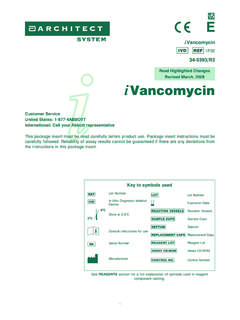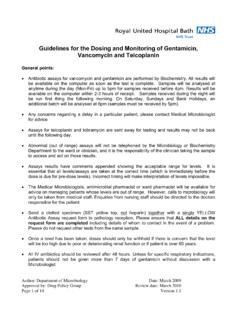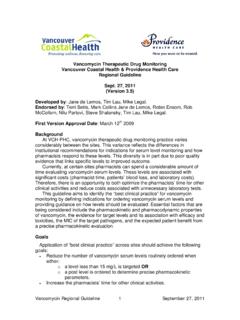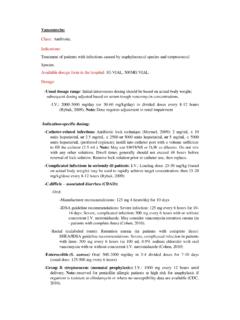Transcription of VANCOMYCIN 1. Product Name 2. Qualitative and …
1 Page 1of 11 NEW ZEALAND DATA SHEETVANCOMYCIN1. Product NameVancomycin 500 mg and 1000 mg powder for Qualitative and Quantitative CompositionEach vial contains 500 mg or 1000 mgof VANCOMYCIN base. 3. Pharmaceutical FormVancomycin powder for infusion is a white to almost white lyophilised powder which has been prepared in a sterile reconstituted in water, it is a clear solution with a pH of Clinical Therapeutic indicationsVancomycin hydrochloride is indicated for potentially life-threatening infections which cannot be treated with another effective, less toxic antimicrobial drug, including the penicillins and hydrochloride is useful in therapy of severe staphylococcal (including methicillin resistant staphylococcal) infections in patients who cannot receive or who have failed to respond to the penicillins and cephalosporins or who have infections with staphylococci that are resistant to other antibiotics.
2 Once sensitivity data are available, therapy should be adjusted hydrochloride is effective alone or in combination with an aminoglycoside for endocarditis caused by S. viridansor S. bovis. For endocarditis caused by enterococci ( ), VANCOMYCIN hydrochloride is effective only in combination with an aminoglycoside. VANCOMYCIN hydrochloride is effective for the treatment of diptheroid endocarditis. VANCOMYCIN hydrochloride is used in combination with rifampicin, an aminoglycoside, or both in early-onset prosthetic valve endocarditis caused by S. epidermidisor effectiveness of VANCOMYCIN has been documented in other infections due to staphylococci including osteomyelitis, pneumonia, septicaemia and, skin and skin structure infections. When staphylococcal infections are localised and purulent, antibiotics are used as adjuncts to appropriate surgical for bacteriological cultures should be obtained in order to isolate and identify causative organisms and to determine their susceptibilities to VANCOMYCIN hydrochloride should be administered orally for the treatment of staphylococcal enterocolitis and antibiotic-associated pseudomembranous colitis (produced by C.)
3 Difficile). Parenteral administration of VANCOMYCIN hydrochloride alone is inappropriate for this indication. Page 2of 11 VANCOMYCIN hydrochloride is not effective by the oral route for other types of infections. For oral administration the parenteral formulation may be used. Some systemic absorption may occur following oral administration in patients with pseudo-membranous Dose and method of administrationDoseAdultsThe usual intravenous dose is 500 mg every 6 hours or 1g every 12 hours. A 500 mg dose of VANCOMYCIN hydrochloride should be infused over a period of at least 60 minutes, whereas a 1 g dose should be administered over a period of at least 2 hours. VANCOMYCIN must not be given by intramuscular injections (see section ).Loading doseThe initial dose should be no less than 15 mg/kg, even in patients with mild to moderate renal populationsAdults with impaired renal function and the elderlyDosage adjustment must be made in patients with impaired renal function to avoid toxic serum levels.
4 In the elderly, dosage reduction may be necessary to a greater extent than expected because of decreasing renal function. Measurement of VANCOMYCIN serum concentrations is required to optimise therapy, especially in seriously ill patients with changing renal function. VANCOMYCIN serum concentrations may be determined by use of a microbiological assay, a radioimmunoassay, a fluorescence polarization immunoassay, a fluorescence immunoassay, or high-pressure liquid most patients with renal impairment or the elderly, the dosage calculations may be made by using the following table. The VANCOMYCIN dose per day in milligrams is about 15 times the glomerular filtration rate in ml/minute (see table below).Dosage table for VANCOMYCIN in patients with impaired renal functionCreatinine clearance(ml/min) VANCOMYCIN dose(mg/24h)1001,545901,390801,235701,08 0609255077040620304652031010155 Anephric patientsThe table is not valid for functionally anephric patients.
5 For such patients, an initial dose of 15 mg/kg bodyweight should be given in order to promptly achieve therapeutic serum concentrations. The dose required to maintain stable concentrations is mg/kg/24hours. Since individual maintenance doses of 250 (250,000 IU) 1,000 (1000,000 IU) mg are convenient, in patients with Page 3of 11marked renal impairment, a dose may be given every several days rather than on a daily basis. In anuria, a dose of 1,000 mg every7 to 10 days has been majority of patients with infections caused by organisms susceptible to the antibiotic show a therapeutic response by 48 - 72 hours. The total duration of therapy is determined by the type and severity of the infection and the clinical response of the patient. In staphylococcal endocarditis, therapy for three weeks or longer is paediatric dosage of VANCOMYCIN is calculated on the basis of 10 mg/kg bodyweight every six hours after an initial loading dose of 15 mg/kg.
6 Each dose should be administered over a period of at least 60 and neonatesIn neonates and young infants, the total daily intravenous dosage may be lower. An initial dose of 15 mg/kg is suggested, followed by 10 mg/kg every 12 hours in the first week of life and every 8 hours thereafter until one month of age. Close monitoring of serum VANCOMYCIN concentrations is mandatory in these patients. Each dose should be administered over a period of at least 60 of administrationOral administrationThe usual adult total daily dosage for antibiotic associated pseudomembranous colitis produced by C. difficile is 500 mg to 2 g in 3 or 4 divided doses for 7 to 10 days. The total daily dosage in children is 40 mg/kg bodyweight in 3 or 4 divided doses. The total daily dosage should not exceed 2 g. The contents of one 500 mg (500,000 IU) vial may be diluted in 30 mlof distilled or deionised water and given to the patient to drink, or the diluted material may be administered via nasogastric tube.
7 Common flavouring syrups may be added to the solution to improve the taste for oral powder, diluted solution for oral use can be stored for 96 hours at 2 C to 8 C or 24 hours below 25 of solution for injectionAt the time of use, the 500 mg (500,000 IU) vial should be reconstituted with 10 ml of Water for Injections. The resulting solution contains VANCOMYCIN 50 mg/ml. The 1 g (1,000,000 IU) vial should be reconstituted with 20 ml of Water for Injections. The resulting solution contains VANCOMYCIN 50mg/ml. The reconstituted solution containing 500 mg of VANCOMYCIN must be further diluted with at least 100 ml of Sodium Chloride Intravenous Infusion or Glucose IntravenousInfusion 5%. The reconstituted solution containing 1 g of VANCOMYCIN must be further diluted with at least 200 ml of Sodium Chloride Intravenous Infusion or Glucose Intravenous Infusion 5% to a concentration of not more than 5 mg/ml.
8 The resulting solution should be infused over a period of at least 60 minutes when 500 mg of VANCOMYCIN is to be administered, or at least 2 hours when 1 g of VANCOMYCIN is to be given. In selected patients in need of fluid restriction, a concentration of up to 10 mg/ml may be used; use of such higher concentration may increase the risk of infusion related events. Infusion related events may occur, however, at any rate of volumes500 mg vial: following reconstitution with 10 ml of Water for Injections, the average displacement volume is ml. 100 mg vial: following reconstitution with 20 ml of Water for Injections, the average displacement volume is 4of 11 Stability of reconstituted solutionSolutions of VANCOMYCIN hydrochloride 50 mg/ml(50,000 IU/ml) in Water for Injections do not show significant loss of potency when stored at 2 C to 8 C for 96 diluted to a concentration of either 10 mg/ml or 1 mg/ml with Sodium Chloride Intravenous Infusion or Glucose Intravenous Infusion 5%, VANCOMYCIN was chemically stable for 14 days at 2 C to 8 reduce microbiological hazard, the infusion should be commenced as soon as practicable after reconstitution/preparation.
9 If storage is necessary, the solution should be held at 2 C to 8 C for not more than 24 ContraindicationsVancomycin hydrochloride is contraindicated in patients with known hypersensitivity to the active Special warnings and precautions for useRapid bolus administration ( over several minutes) may be associated with exaggerated hypotension, including shock, and, rarely, cardiac hydrochloride should be administered in a dilute solution at a rate not exceeding 500mg/hour to avoid rapid-infusion-related reactions, hypotension, flushing, erythema, urticaria and pruritus. Stopping the infusion usually results in a prompt cessation of these reactions (see sections and ).When given intravenously, toxic serum levels can occur. VANCOMYCIN is excreted fairly rapidly by the kidney and blood levels increase markedly with decreased renal clearance.
10 During parenteral therapy, the risk of toxicity and nephrotoxicity appears appreciably increased by high blood concentrations or prolonged of its nephrotoxicity, VANCOMYCIN should be used with care in patients with renal insufficiency. If it is necessary to use VANCOMYCIN parenterally in patients with renal impairment, the dose and/or dose intervals should be adjusted carefully (see section ) and blood levels monitored. Serial monitoring of renal function should be patients receive concomitant therapy with an aminoglycoside, serial monitoring of renal function should be has occurred when serum levels exceeded 80 mcg/ml. It may be transient or permanent. Deafness may be preceded by tinnitus. The elderly are more susceptible to auditory damage. Experience with other antibiotics suggests that deafness may be progressive despite cessation of hydrochloride should be avoided (if possible) in patients with previous hearing loss.
















